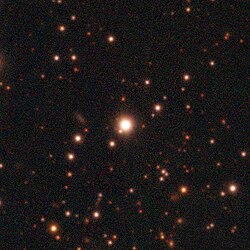| Observation data Epoch J2000 Equinox J2000 | |
|---|---|
| Constellation | Ophiuchus[1] |
| Right ascension | 17h 28m 41.09661s[2] |
| Declination | −00° 34′ 51.5234″[2] |
| Characteristics | |
| Sun-like star | |
| Evolutionary stage | Main sequence |
| Spectral type | G[3] |
| Apparent magnitude (G) | 13.77[3] |
| Black hole | |
| Evolutionary stage | Stellar black hole |
| Astrometry | |
| Radial velocity (Rv) | 23.03±2.63[2] km/s |
| Proper motion (μ) | RA: −7.70±0.020 mas/yr[3] Dec.: −25.85±0.027 mas/yr[3] |
| Parallax (π) | 2.09 ± 0.02 mas[3] |
| Distance | 1,560 ± 10 ly (478 ± 5 pc) |
| Orbit[3] | |
| Period (P) | 185.59±0.05 d |
| Semi-major axis (a) | 1.40±0.01 AU |
| Eccentricity (e) | 0.451±0.005 |
| Inclination (i) | 126.6±0.4° |
| Longitude of the node (Ω) | 97.8±1.0° |
| Periastron epoch (T) | 2457387.9±0.7 |
| Argument of periastron (ω) (secondary) | 12.8±1.1° |
| Details[3] | |
| Sun-like star | |
| Mass | 0.93±0.05 M☉ |
| Radius | 0.99±0.05 R☉ |
| Luminosity (bolometric) | 1.06±0.04 L☉ |
| Surface gravity (log g) | 4.55±0.16 cgs |
| Temperature | 5850±50 K |
| Metallicity [Fe/H] | −0.2±0.05 dex |
| Rotational velocity (v sin i) | <3.5 km/s |
| Black hole | |
| Mass | 9.62±0.18 M☉ |
| Other designations | |
| Database references | |
| SIMBAD | data |
Gaia BH1 (Gaia DR3 4373465352415301632) is a binary system consisting of a G-type main-sequence star and a likely stellar-mass black hole, located about 1,560 light-years (478 pc) away from the Solar System in the constellation of Ophiuchus.[4] As of May 2024[update], it is the nearest known system that astronomers are reasonably confident contains a black hole, followed by Gaia BH3, Gaia BH2 and A0620-00.[3][5]
- ^ "Finding the constellation which contains given sky coordinates". djm.cc. 2 August 2008.
- ^ a b c Cite error: The named reference
GaiaDR3was invoked but never defined (see the help page). - ^ a b c d e f g h Cite error: The named reference
El-Badry2022was invoked but never defined (see the help page). - ^ Overbye, Dennis (5 November 2022). "Astronomers Find a Black Hole in Our Cosmic Back Yard - Just 1,600 light-years away, the black hole is the closest known to Earth. The good news: It's dormant, at least for now". The New York Times. Retrieved 6 November 2022.
- ^ Cite error: The named reference
NOIRLab2227was invoked but never defined (see the help page).
